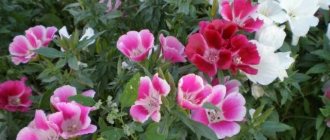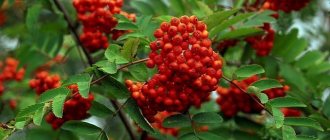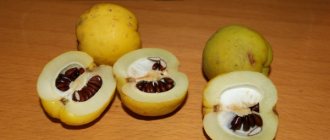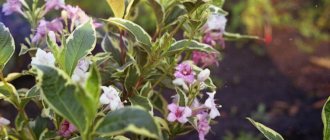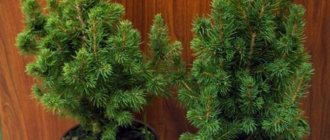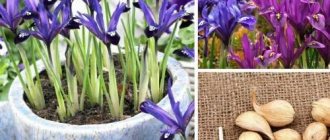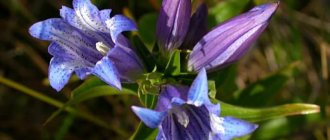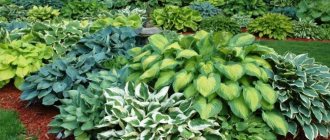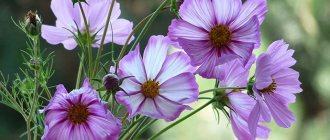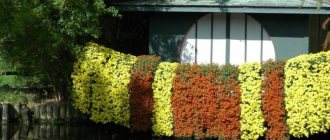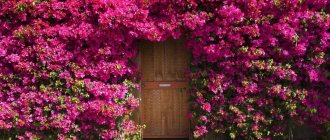Barberry Thunberg - description
Thunberg barberry is a shrub up to 2.5 m high with deflected arched ribbed branches, red or red-orange shoots, which become dark brown or brown over time. Both shoots and branches are covered with simple and elastic spines up to 1 cm long. The leaves of this plant are round, spatulate or oval-diamond-shaped, slightly pointed or rounded at the top and wedge-shaped at the base. The length of the leaves together with the cuttings can reach 2 cm, and the width - 1 cm. The leaves of Thunberg barberry are bright green on the upper side, bluish below, and in the fall they turn bright red. The flowers of the Thunberg barberry, single or collected in 2-5 pieces in bunches or brushes, are yellow on the inside and red on the outside, reaching a diameter of 1 cm. The fruits of the Thunberg barberry are coral-red shiny ellipsoidal berries up to 1 cm long. Flowering occurs in May , fruiting - in early or mid-autumn.
Features of culture
Barberry Koronita is a medium-sized ornamental shrub that has arched branches. The height of the bush does not exceed 0.5-1 m. The shape of the plant is quite spreading, cushion-shaped. The bush can reach up to 1.5 m in width
The root system is superficial, it is important to be very careful when weeding, removing weeds and loosening the root zone. During the season, the growth of the bush averages about 10 cm
In total, Coronita stands out among other varieties with its original appearance. The peculiarity of this variety is that the bright beautiful leaves sometimes change color to bright purple in autumn.
Even the thorns of the bushes are very bright and immediately attract attention. They are quite large in size, pink in color, with a creamy tint, juicy and attractive
Barberry Thunberg Koronita
Another feature of the variety, which is successfully used by most gardeners and landscape designers, is that the plantings can be given any shape and appearance by cutting the branches. The inflorescences, located densely along the entire length of the branches, have a bright yellow color. In the harsh climatic conditions of the Russian climate, the plant adapts perfectly and grows well without much difficulty, and feels great in both hot and cool weather.
Koronita barberry blooms towards the end of spring, and in autumn the bushes are decorated with beautiful bright red fruits. But you shouldn’t eat them, as they are not only inedible, but also poisonous. When eating the fruits, serious digestive disorders and poisoning can occur. The only purpose of the fruit is to additionally decorate the bushes.
Planting Thunberg's barberry
When to plant Thunberg barberry
It is best to plant Thunberg barberry in the fall, during the leaf fall period: before winter the plant will have time to take root, but will not begin to grow, since with the onset of cold weather it will enter a dormant period. You can plant Thunberg barberry in the spring, but you need to do this before the buds begin to swell, although seedlings with a closed root system can be planted throughout the growing season.
Success in growing Thunberg barberry can only be achieved by creating the necessary conditions for its growth and development, so you need to take a responsible approach to choosing a place for it. Almost all barberries of this species prefer open sunny areas, protected from cold winds. Varieties with red and purple leaves require more bright light, while varieties with dark green foliage grow well in both sun and partial shade. The soil composition should be light and well drained. In areas with heavy soils that are poorly permeable to air and moisture, planting holes are filled with specially prepared soil, consisting of 2 parts of turf soil, into which one part each of humus and sand is added. As for the pH value of the soil, Thunberg barberry can grow in acidic soil, but neutral soil (6-7.5 pH) is still preferable, so add 200 g of wood ash or 300-400 g of slaked lime to acidic soils before planting. every plant.
How to plant Thunberg barberry
Prepare a planting pit for the seedling with a depth and diameter of about half a meter. The interval between two plants should be at least one and a half meters; for dwarf varieties of shrubs, a distance of 50 cm is sufficient, but if you are going to grow a hedge of Thunberg barberry, then it is better to dig not holes under it, but a trench 50 cm deep and wide and place it in there are two seedlings per 1 m².
A layer of sand 10 cm thick is laid at the bottom of the hole for drainage, then a mound of soil is poured in the center, a seedling is placed on it, its roots are straightened and the remaining space is filled with earthen mixture. After planting, the surface around the seedling is lightly compacted and watered abundantly. When the water is absorbed, the tree trunk circle is mulched with organic material, for example, humus or peat, after which the seedling is pruned, leaving no more than three buds on each branch.
Preferences for soil and planting site
Barberry is characterized by tolerance to sunny places. Partial shade is allowed, but with strong shading, the decorative appearance of the crown is lost. Planting is carried out on fresh alkaline soils with drainage in urban and suburban conditions. Some agronomists claim that this variety is susceptible to sunburn in spring and recommend planting it in light partial shade. When planting, you need to loosen the soil and not over-moisten it. It is better to avoid places with possible stagnation of groundwater. To protect against freezing, it is recommended to plant Aurea in areas protected from wind.
Caring for Thunberg barberry
Planting and caring for Thunberg barberry is practically no different from the process of growing any other ornamental shrub. The first time after planting and until the plant begins to grow, it is watered no more than once a decade, and later, when the barberry becomes mature, watering will only be needed during a period of prolonged drought, and the rest of the time natural water will be sufficient precipitation. Build an earthen roll about 10 cm high around the perimeter of the tree trunk circle so that when watering the water does not spread over the area, but is absorbed into the ground around the bush. To moisten the soil, water heated in the sun is used, which is poured under the root. When the water is absorbed, you can loosen the soil in the root zone and remove weeds.
As fertilizers, it is preferable to use organic matter - humus or compost, which is applied every spring to the tree trunk circle for digging up the soil, and in the fall the root area is covered with peat or dry compost. Once every three to four years in the spring, each plant is fertilized with a solution of 20-30 g of urea in 10 liters of water. If you prefer to feed barberry with mineral complexes, then Kemira-universal has proven itself best in this regard, a solution of 15 g of which in a bucket of water is poured into the trunk circle of each barberry at the beginning of July and at the end of the season.
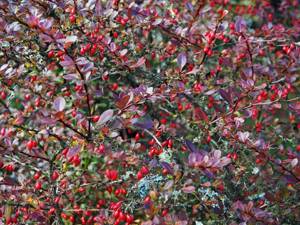
It is not necessary to prune Thunberg barberry, except that you will have to shorten some of the shoots protruding from the spreading crown, which give the plant a sloppy appearance. However, sanitary cleaning will have to be carried out every spring: when young leaves appear on the plant and it becomes obvious which shoots of the bush have suffered from frost, cut them back to healthy tissue, and also cut out damaged, dry, diseased branches that thicken the bush.
In late autumn, the trunk circles of Thunberg barberry are covered with organic material, and young plants up to five years old in places with frosty winters are protected from frost with spruce branches. Large barberry bushes in cold regions are covered like hydrangeas or roses, tied with twine and fenced with a metal mesh cylinder, the height of which should exceed the bush by 10 cm. The space between the bush and the walls of the mesh cylinder is filled to the top with dry leaves, after which the cylinder is covered with spunbond or lutrasil .
When is it better to plant barberry - in spring or autumn?
Barberry, like many other shrubs, can be planted in both spring and autumn, especially if you purchased a container plant, and it is in this form that it is sold in most garden centers and nurseries.
Planting dates in spring and autumn
If you decide to plant barberries in the spring, then you need to do this immediately after the temperature outside is above zero and the snow has melted.
For example, in the central zone (Moscow region), barberry is planted in the spring starting in April (usually in the 2-3rd decade).
Autumn planting of barberry can be done until stable frosts and freezing of the ground are established, but it is better to do this 2-3 weeks before, so that the plant has time to take root well in the new place before wintering.
In other words, the approximate time for planting barberry in the fall in the middle zone (Moscow region) is September to the first half of October (if the autumn is warm, then, of course, it can be planted at the end of October).
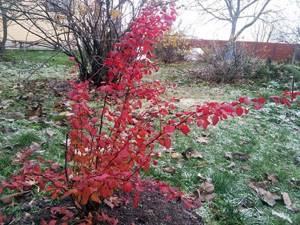
Video: planting barberry in autumn
According to the lunar calendar in 2021
can help you choose the optimal date for planting seedlings .
Thus, favorable days for planting barberry in 2020, according to the lunar calendar, are:
- in March - 26-29;
- in April - 11-15, 24, 25;
- in May - 2-10;
- in September - 19-26;
- in October - 3-13, 18-21.
Of course, it is not always possible to get to the dacha on favorable days, so the main thing is not to land on unfavorable dates (Full and New Moon days, as well as the period when the Moon is in Aquarius, since this is a barren and dry sign - italicized) .
for planting barberry seedlings in 2020
- in March - 9, 19-21, 24;
- in April - 8, 15-17, 23;
- in May - 7, 13-14, 22;
- in June - 5, 9-11, 21;
- in July - 5, 7-8, 20;
- in August - 3, 4-5, 19, 31;
- in September - 1, 2, 17, 27-28;
- in October - 2, 16, 24-26, 31;
- in November - 15, 20-22, 30.
According to the lunar calendar, from the magazine “1000 tips for a summer resident.”
Reproduction of Barbars Thunberg
Thunberg barberry is propagated by seeds, cuttings, shoots, layering and dividing the bush.
Only species plants are propagated by seeds, since varietal characteristics are not preserved using the generative method. However, it is thanks to generative propagation that new plant varieties appear. The problem with the seed method is that only 15 to 40 percent of the seed germinates. To improve germination, the seeds need to be scarified, that is, slightly damage the tight shell, which does not allow the sprout to break out. After scarification, the seeds are sown in the fall in open ground to a depth of 4-5 cm, where they undergo natural hardening during the winter months, and in the spring you will be able to see seedlings that will need to be grown for 2-3 years until the seedlings are transplanted to a permanent place.
If you want to preserve the varietal characteristics of the plant you like, it is better to propagate it vegetatively. For example, semi-lignified cuttings about 15 cm long or green cuttings with two or three internodes and an oblique lower cut. To speed up the root formation process, the lower cut of the cuttings is treated with a growth stimulator, after which the cuttings are planted in a peat-sand substrate, positioned at an angle and covered with a transparent cap with holes made for ventilation. It will be possible to remove the covering only when new leaves begin to appear on the cuttings.
The easiest way to propagate Thunberg barberry is by layering: lay the low-growing branches of the bush on the ground, secure in this position and sprinkle with fertile soil. During the season, water and feed them at the same time as the mother plant, and in the fall, separate the rooted cuttings from the bush and plant them in a permanent place.
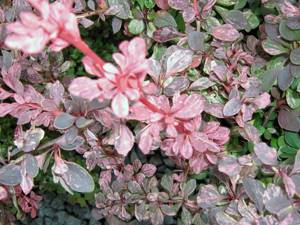
It is advisable to divide the bush only if there is a need to replant the plant, since there is a risk of damaging the roots of the mother plant during the procedure. Both replanting and dividing the bush should be carried out in the spring, before sap flow begins, or in the fall, after leaf fall. The bush is dug up, its roots are carefully freed from the ground, after which the bush is divided so that each part has healthy, strong roots and shoots. The delenki are immediately planted in pre-prepared pits.
How to plant?
When planting, you must follow several basic rules.
The location is determined so that the site is well lit throughout the day
Even short-term exposure to shade leads to changes in the qualitative characteristics of the crop. Excess moisture can be extremely negative for the Atropurpurea barberry, so it is important to avoid lowlands and areas with high groundwater levels. The distance between plants should be sufficient, since barberry is prone to overgrowth. Naturally, in the case of forming a hedge, the seedlings are grown closer. In the event that spring planting is planned, the soil should be prepared in the fall.
If the crop is planted in the autumn months, then preparation begins approximately 4 weeks in advance. It is important to avoid high acidity, therefore, if this parameter is violated, lime or dolomite flour is added to the soil. Loam and black soil are lightened using peat and sand. The size of the hole to be dug is determined depending on the age and size of the plant. When planting seedlings under two years old, a width and depth of 25 and 30 centimeters will be sufficient. When replanting a bush older than three years, you will need to dig a hole, the diameter and depth of which are 50 centimeters. If Thunberg's barberry "Atropurpurea" is to become part of a hedge, then it will be necessary to dig a trench, the width and depth of which will be 40 centimeters. While the hole is being created, the top fertile layer of soil will need to be mixed with a couple of buckets of sand, a couple of buckets of compost and 100 grams of superphosphate. The resulting hole is moistened, and then the seedling is placed in it. Each seedling should already have a well-developed root system, which is free of dried and damaged pieces. It is necessary to ensure that there are four or more shoots covered with smooth red-yellow bark. It will be important to disinfect the shoots using fungicides, as well as stimulate the seedling in a special solution. The seedling in the hole is installed vertically, and its roots must be straightened. After filling the plantings with soil mixture, it is necessary to ensure that the root collar rises at a level of 5 centimeters from the surface. However, if the bush is subject to division in the future, experts recommend deepening the root collar. Planting is completed by irrigating and mulching the tree trunk circle. If planting occurs in the spring, then it is better to use organic matter as mulch, and if in the fall, then straw or dried leaves. All work is recommended to be carried out in the morning before sunrise or in the evening after sunset.
The barberry "Atropurpurea" can be propagated by seed, but the process will take a long time. First, in the autumn, seeds are extracted from the fruits, which are kept in a manganese solution for about 40 minutes. After drying the material, it can be immediately sent to the garden. The next year, after a couple of leaves appear on the barberry, it will have to be pruned. The culture is transferred to its permanent habitat only in the third year of life.
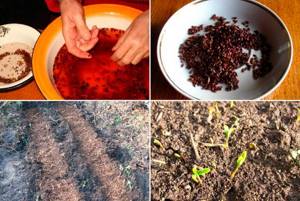
Vegetative propagation occurs by cuttings, layering or division. The cuttings are cut in the last week of June and, having been treated with growth stimulants, are planted in containers under a plastic or glass “roof”. It will take barberry about a year to form a reliable root system, after which it can be planted in a permanent area. Work with layering starts in early spring. Healthy annual shoots are fixed to the surface with staples and sprinkled with earth. In this case, it is imperative to ensure that the top of the head rises above the ground level. In the fall, "Atropurpurea" should already form roots.
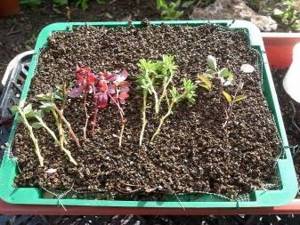
Diseases and pests of barberry Thunberg
Thunberg barberry suffers from powdery mildew, spots, rust and drying of shoots, but if the plant is well cared for, then nothing threatens its health: the infection can only affect a weakened or neglected plant.
Powdery mildew settles on the ground organs of the bush with a dirty whitish coating, which gradually darkens and becomes brown. The disease is treated by treating barberry with colloidal sulfur or sulfur-lime mixture, after first removing severely affected branches and shoots.
Spots cover the leaves and stems of shrubs with spots and specks of different shapes, sizes and colors. As the disease progresses, the affected leaves dry out and fall off. They get rid of this scourge caused by fungi by treating the bush leaf by leaf before and after flowering with a solution of 30 g of copper oxychloride in 10 liters of water.
Sometimes in the spring, orange spots may be seen on the upper side of the leaves of the Thunberg barberry, and on the underside there are pads of spores of the fungus that causes a disease known as rust. If the disease takes effect, the leaves of the bush will quickly dry out and fall off. This dangerous infection is destroyed with a one and a half percent solution of colloidal sulfur or a two percent solution of Bordeaux mixture as soon as the leaves open on the plant. Repeat this treatment twice more with an interval of three weeks.
Some fungi can cause barberry shoots to dry out. To stop this destructive process, at the first symptoms of the disease, you should cut off the damaged shoots to healthy tissue, and treat the bush with a fungicide solution.
From time to time, Thunberg's barberry is bothered by aphids and flower moths, and if you find insects on a bush, do not expect them to disappear on their own: pests such as aphids can produce several generations in one season, and if they are not destroyed, then deformed flowers, prematurely yellowing and falling leaves and drying shoots can appear not only on barberry, but also on neighboring plants. In addition, sucking pests carry incurable viral diseases. If you find barberry aphids, do not waste your time fighting it with folk remedies; it is better to immediately treat the shrub with an insecticide, for example, Aktellik, Aktara or Biotlin. And flower moths are destroyed with a solution of Decis or Chlorophos.
How to properly care?
The main care for Thunberg's Golden Ring barberry consists of regular watering and feeding. In addition, to form a beautiful crown, periodic pruning of the plant will be required. When planting in a hedge, the shrub should receive more attention. It is recommended to trim it regularly to give it shape, monitor for possible pest infestations, and control soil moisture.

Watering and fertilizing
In the first year after planting, the plant needs regular and abundant watering. Moisture should be added weekly, at the root, avoiding water getting on the branches and leaves. During this period, there is no need for additional fertilizing; the substances added during soil preparation will be quite sufficient. For the 2nd year, you can provide the shrub with additional nutrition in the form of ammonium nitrate dissolved in 1 bucket of water, a volume the size of a matchbox is sufficient. This is the dosage for 1 barberry; fertilizer is applied individually for each plant.
In the future, feeding is carried out periodically. It is needed no more than once every 4-5 years. Since the bush's lifespan exceeds 60 years, this is quite enough to keep the plant in good shape. Mature shrubs also do not require additional watering, especially during periods of heavy rainfall. During dry periods, it will be enough to apply 10 liters of water per plant weekly at the root. To prevent water from stagnating at the roots and the soil from drying out without watering, it is recommended to periodically weed and loosen the tree trunk circle. The depth of soil excavation should not exceed 3 cm; you can use an aerator or a regular hoe. After loosening, the surface of the earth is mulched again.
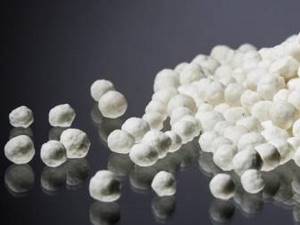
Trimming
Like other shrubs grown for ornamental purposes, the Thunberg barberry variety “Golden Ring” requires regular pruning. Sanitary removal of damaged or frozen shoots is carried out annually. It is carried out in early spring, and all dry and non-viable branches are removed. After sanitary pruning, all treated areas must be lubricated with copper sulfate or garden pitch to prevent the development of diseases in the plant. Shoots of the second year can be processed in the fall.
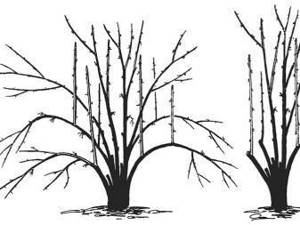
The following manipulations are performed.
- Anti-aging pruning. It is carried out for plants that have never received crown formation or have been left without attention and care for a long time. In this case, in the first year, up to 1/3 of shoots older than 3 years are removed. The following year the procedure is repeated again.
- Thinning. In this case, only the strongest shoots of 1 year are preserved. Such pruning is necessary for shrubs with a carefully formed crown. It is carried out annually, removing all unnecessary shoots and shortening them to the ground.
- Hedge trimming. Some of the shoots are cut off at the root, the rest are shortened by 1/3, forming a compact bush with a clear geometry. The side shoots become more compact, the plant does not look spreading, and remains within the specified growth boundaries.
When pruning Thunberg barberry, it is important to remember to protect your hands and body - the bushes are very thorny and can scratch
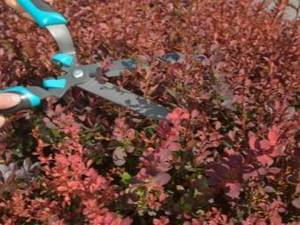
Preparing for winter
The Golden Ring variety, like other subspecies of barberry, does not require special winter preparation. Thunberg barberry is winter-hardy, but if the frosts are very severe, it is still recommended to organize a shelter made of non-woven material and spruce branches for 1-year-old shoots. From 2 years after planting, the plant is not covered. After freezing, the bush recovers quite easily, producing young shoots.
Thunberg barberry varieties
Barberry Thunberg is the most beautiful plant of the Barberry genus. The height of Thunberg barberry can reach from 50 cm to 2 meters or more. The plant has several garden forms: multi-flowered, dark purple, silver-edged, Maksimovich, single-flowered and minor - a dwarf bush up to 50 cm tall. As for the varieties of this species, their number forced botanists to create a separate classification. We offer you a brief description of the Thunberg barberry varieties, among which you will surely find a plant for your garden. Dwarf varieties of Thunberg barberry are of particular value . For example:
- barberry Thunberg Atropurpurea Nana, or Crimson Pijmi, or Little Favorite - a plant about 60 cm high and about 1 m in diameter with a compact cushion-shaped crown, reddish-brown bark and purple foliage, which becomes lighter and brighter in autumn;
- barberry Thunberg Gold Bonanza - a shrub up to half a meter high with a crown diameter of about 70 cm, orange leaves and shoots of the same color;
- barberry Thunberg Kobold - a bush up to 50 cm high with a spherical compact crown, reddish-brown bark and dark green shiny leaves, which acquire a beautiful yellow or red color in autumn;
- barberry Thunberg Aurea - a plant up to 80 cm in height and up to 100 cm in diameter with a rounded crown and foliage, colored in the range from lemon yellow to golden yellow;
- Thunberg barberry Bagatelle - a variety up to 40 cm high with beet leaves, which have a brownish tint in the summer and turn bright red in the fall;
- barberry Thunberg Koronita is a plant reaching a height of 50 cm and a diameter of one and a half meters, with dark red leaves with a pale green border at the edges.
Barberry Thunberg with purple, red or orange leaves is represented by the following varieties:
- Thunberg barberry Orange Rocket is an upright shrub with red-orange foliage, reaching a height of 120 and a diameter of 60 cm;
- Thunberg Red Rocket barberry - a two-meter tall plant with red-orange leaves that turn yellowish-orange in the fall;
- barberry Thunberg Darts Red Lady - a spherical bush about 80 cm high with shiny, dark red leaves that turn yellow in autumn;
- Thunberg Red Pillar barberry is a shrub up to one and a half meters tall with red leaves with a purple tint. In autumn the leaves turn scarlet;
- Thunberg's barberry Golden Ring is a plant up to three meters high with dark purple leaves edged with a yellow stripe. In autumn, the foliage of this variety turns bright red.
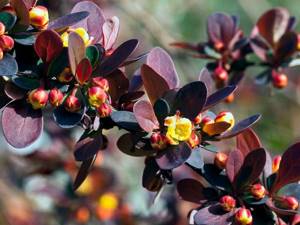
For those who need a shrub with green or yellow leaves , the following varieties are suitable:
- Barberry Thunberg Erecta is a narrow-columnar bush up to one and a half meters high. In maturity, the crown of this variety becomes spreading. The leaves are small, light green, turning yellow in autumn;
- Thunberg barberry Green Carpet is a variety up to 1 m high with a crown diameter of up to 1.5 m with light green leaves in summer and scarlet-red leaves in autumn. The fruits of this variety are pink or red;
- Thunberg Maria barberry is a variety bred by Polish breeders with a columnar crown up to 1 m high. Young leaves have a reddish tint, and with age they turn yellow.
But varieties with variegated foliage :
- Thunberg Harlequin barberry is a plant up to 150 cm high and up to 120 cm in diameter with red shoots when young and red leaves with white and pink spots. The yellow flowers that open during flowering contrast effectively with the leaves. This variety resembles the Thunberg Rose Glow barberry, which has more variegated leaves and different shades of color;
- Thunberg's Pink Queen barberry is a spreading bush, reaching a height of 120 cm. Its brown leaves are covered with red-pink and gray strokes, but in the fall they become crimson in color.
In addition to those described, Thunberg barberry varieties Golden Dream, Admiration, Orange Dream, Tony Gold, Harmony, Cherry Bomb, Sunny, Sensation, Sideshow, Golden Ruby Sparkle and many others are often grown in gardens.
Barberry Aurea in landscape design
The main use of barberry Aurea is decorative. The shrub has become widespread as part of a composite tree and shrub composition in landscape design in gardens, parks, personal plots, and on the banks of a reservoir. The yellow color of Barberry aurea creates a contrast with the surroundings and enlivens the area, attracting attention to itself.
Bright inclusions of their varied colors are created by bushes of Thunberg Aurea barberry of different varieties, if they are planted in one area one at a time or in groups, as seen in the photo.
Barberry Aurea tolerates urban pollution well, so it is often planted to decorate city parks and streets, and create low hedges and borders.
